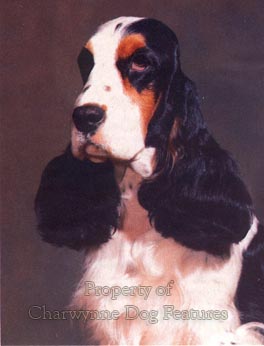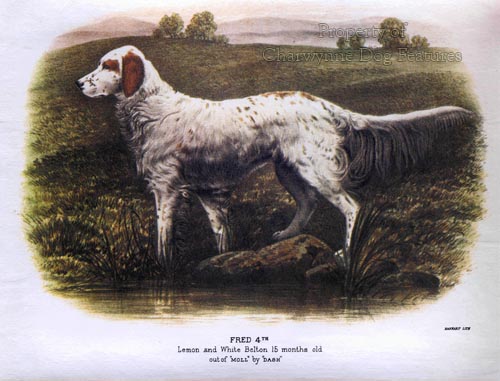602 Hunting Breed Stds
HUNTING FOR A STANDARD
by David Hancock
 But who is going to act as breed-guardian when breeding accidentally produces an undesired result or when a misguided clique try to dominate the thinking over the essential type in a breed? At the turn of the century it might have been a member of the landed gentry standing firmly behind the value of heritage and a noble desire to honour inheritance without financial advantage; not any more. Breed societies and the respective councils have a key role, with the Kennel Club having the self-set role as keeper of the written blueprint for each and every pedigree breed. But does that work?
But who is going to act as breed-guardian when breeding accidentally produces an undesired result or when a misguided clique try to dominate the thinking over the essential type in a breed? At the turn of the century it might have been a member of the landed gentry standing firmly behind the value of heritage and a noble desire to honour inheritance without financial advantage; not any more. Breed societies and the respective councils have a key role, with the Kennel Club having the self-set role as keeper of the written blueprint for each and every pedigree breed. But does that work?
Putting aside for a moment the wisdom of the wording of the breed standards, are the words in the breed standards themselves being respected? Take the KC-approved standard of a number of breeds and see if the wordy descriptions contained in them have any credibility. In the case of the basset hound, the eyes can have red in the lower lid "though not excessively". The ears can reach well beyond the nose but "not excessively so". I see basset hound after basset hound with an excess of haw and leather-length and they win! Look at the desired muzzle of one of my favourite breeds the bullmastiff: "distance from tip of nose to stop approximately one third of length from tip of nose to centre of occiput". But when I look at this fine breed at shows, I see pug-face after pug-face, with no regard given to the breed blueprint either by the exhibitors or the judges. Why not ?
Are we breeding to suit breeder-whim or because we wish to sell our stock even if it doesn't match our particular breed's characteristics? If the former, why is it being condoned? Who's in charge? If the latter, how dare any one destroy a breed in this way and get away with it! I can understand different readers interpreting any breed standard in individual ways quite innocently. But there is nothing innocent when crystal-clear, totally unambiguous direction is provided -- and then brazenly ignored by both breeders and exhibitors...and then judges in their turn. Sounds like a conspiracy -- or defiance!
In the breed standards of the gundog group for example: the field spaniel is required to have its tail docked by 1/3rd; all the fields I see have their tails docked by 2/3rds. Forget the docking dilemma for a moment -- is there anything ambiguous about this part of the field spaniel's breed standard? The cocker spaniel's ears are described as "extending to nose tip". I see exhibits from this breed winning with ears long enough to wrap around the tip of the dog's nose. The American cocker spaniel is expected to have ears extending to its nostrils; those I see in the show ring have ears way way beyond the dog's nostrils. 
In the hound group, the beagle is supposed to have ears "reaching nearly to end of nose when drawn out". Is it not an expectation therefore for the beagle's ears to be only very slightly shorter than a cocker spaniel's. That can be the only interpretation of the blueprints for the breeds concerned. But we all can see that in reality this is not so. The bloodhound is required to have eyes which are not sunken; go to the ring for this breed at the next show and you will see a high proportion of the bloodhound entry with sunken eyes. How can the fanciers of these breeds claim to have the best interests of their breed at heart when they are knowingly breaching the agreed blueprint for that breed? What are these breeders breeding for? It cannot be for accuracy or breed-loyalty.
I believe we should be breeding our pedigree breeds of dog to honour their ancestry, acknowledge their function, preserve type and perpetuate their key characteristics breed by breed. Every novice in the showdog scene is directed to study the breed standard as the first step in his or her induction to the chosen breed. Most show critiques refer to it. Yet when I advised a potential pointer owner to go to Crufts a few years ago and take the breed standard with him, he rang me later in some confusion. The pointer breed standard states that dogs on the move should definitely not display a hackney action. My colleague saw a pointer not only win its class with a hackney action but win the gundog group as well!
What all this adds up to is a lack of authority in the dog show world, nothing less. Accompanied by a lack of discipline, disrespect for breed function and ignorance of breed history, we have here the elements of approaching chaos, imminent disaster. I can see no sign of a determined, enlightened, informed individual with the personal stature to sort this situation out. Perhaps we need a wealthy patron with the single-minded zeal to bring some much needed authority to the dog game. If we degrade function, ignore blueprints and dismiss breed-purpose for much longer, we could harm the essential type of some breeds irretrievably.
Just over one hundred years ago, the great setter man Edward Laverack was writing: " The first thing to be attended to in breeding is to consider what object the animal is intended for...One of the first objects to obtain if possible is perfection of form as best adapted for speed, nose and endurance. The next and which I consider paramount...is an innate predisposition to hunt and point naturally in search of game and without which innate properties mere beauty of colour and perfection of external form are but secondary considerations to practical sportsmen and simply valueless". Now there's a man we can all respect -- and we ignore his words with massive irresponsibility and great foolishness.